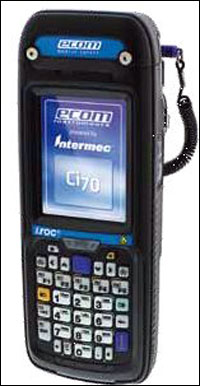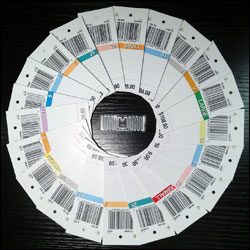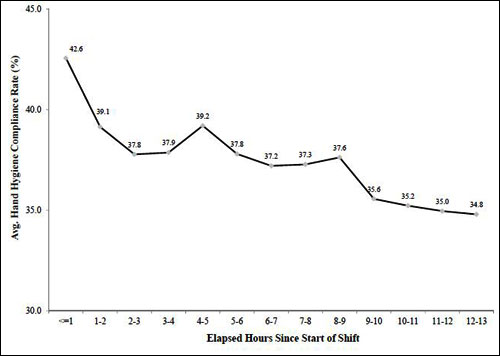The following are news announcements made during the past week related to the following organizations:
ecom instruments;
FineLine;
Proventix;
Protavic;
Texas Instruments; and
LogiTag Systems.
Ecom Instruments Intros UHF Reader for Intrinsically Safe iroc-Ci70 Handheld Computer
Ecom instruments GmbH. has introduced its UNI900 UHF RFID, an ultrahigh-frequency reader designed to work with ecom’s iroc-Ci70 handheld computer. Unveiled in 2012, the iroc-Ci70 (co-developed with Intermec) is an intrinsically safe handheld mobile computer for use in hazardous environments. It includes the option of RFID capability, along with various bar-code scanner capabilities (see link RFID News Roundup: Ecom Instruments, Intermec Partner on Handheld Mobile Computer With RFID Capability).
Ecom offers two versions of the UNI900 UHF RFID reader—the NE-UNI900-AA 868 MHz UHF RFID R/W Module (complying with ETSI regulations) and the NU-UNI900-AA 915 MHz UHF RFID R/W Module (complying with FCC regulations). The new reader, ecom reports, is designed to mitigate concerns users have regarding the use of RFID technology in hazardous areas, including struggles they have with PDA devices that are large and poorly balanced, with difficult-to-use and protruding “bolt-on” UHF readers and antennas that can be snagged on plant equipment and infrastructure, such as ladders. In addition, the company says, users have expressed concerns about scanning the wrong equipment during inspections, since equipment is often moved, as well as the challenges associated with reading smaller RFID tags embedded or mounted on metal. According to the company, typical applications for this device include plant audits and surveys; equipment and tool management; field inventory management; supply chain logistics; operator rounds; inspection, maintenance and repair; emergency mustering; and plant security checks.
The UNI900 UHF RFID reader for ecom’s iroc-Ci70 is designed to operate safely in hazardous areas, and can read and encode UHF RFID tags from both close and long ranges. The antenna performance allows the reading of small tags embedded in and mounted on metal, ecom reports. Connected to the iroc-Ci70 PDA as an integrated head module, the UNI900 head does not have any protruding “bolt-on” modules. An automated Scan N Go capability eases the process of setting it up with the handheld device, ecom notes, and the UNI900 can easily be retrofitted to existing Ci70 devices.
FineLine’s SolidTag Service Offers Fashion RFID Hangtags, Labels in Low Volumes
FineLine Technology has announced a service that provides apparel retailers and brands in North America and Asia with short runs of RFID hangtags and labels that are fully integrated with logos, full-color graphics and variable data. According to FineLine, the new SolidTag service provides these companies with an alternative to fully integrated RFID hangtags and labels that traditionally are only available at very high volumes or at high costs, as well as generally unacceptable turnaround times.
The SolidTag service delivers RFID hangtags and labels with custom graphics, minimal volume commitments and 48-hour service levels. SolidTag offers any inlays that a retailer or brand requires, but the inlays specified by the customer must contain the newer generation of chips, such as Impinj‘s Monza 5 or NXP Semiconductors‘ Ucode 7—that are capable of being read and written to at very high speeds. FineLine offers a free application evaluation for apparel businesses considering fully integrated RFID tagging. “We work with either the retailer or brand to convert their current branded tag into an integrated RFID tag and then provide them with samples, usually a hundred or so at no cost,” says George Hoffman, FineLine’s president and CEO. “These samples are usually first approved by the appropriate merchandiser and then may be subjected to an internal evaluation to ensure they meet the client’s specific RFID performance requirements.”
If clients wish to implement any type of compliance program within their supply chain for RFID-tagged merchandise, FineLine will also work with them to set up a custom solution using its mobile QCTrak. This, Hoffman explains, enables the client to easily implement a compliance program to ensure suppliers are using only client-approved RFID inlays, and that those inlays are performing properly.
Proventix RFID Data Helps Researchers Discover Hand-Washing Compliance Patterns
A group of academic researchers employed RFID-based data to analyze hand-washing compliance among hospital workers who deal directly with patients. The study, titled “The Impact of Time at Work and Time Off From Work on Rule Compliance: The Case of Hand Hygiene in Health Care,” found that workers wash their hands less frequently as their workday progresses, probably because the demands of the job deplete the mental reserves they need to follow rules.
Researchers led by Hengchen Dai, a Ph.D. candidate at the University of Pennsylvania, examined three years’ worth of hand-washing data from 4,157 caregivers at 35 U.S. hospitals. All of the hospitals had installed Proventix RFID system as of February 2013.
Proventix’s system monitors whether health-care workers are washing their hands as recommended (that is, within a specified number of seconds of entering and leaving a patient’s room). To accomplish this, customized readers are installed above the soap or alcohol dispenser at each hand-washing station, and workers are issued active RFID tags. The readers and tags operate at 2.4 GHz and comply with the IEEE 802.15.4 (ZigBee) specification (see RFID-based Hand-Hygiene System Prevents Health-care Acquired Infections).
The researchers found that hand-washing compliance rates dropped by an average of 8.7 percentage points from the beginning to the end of a typical 12-hour shift. This decline in compliance was magnified by increased work intensity. “Just as the repeated exercise of muscles leads to physical fatigue,” the researchers wrote, “repeated use of executive resources (cognitive resources that allow people to control their behaviors, desires and emotions) produces a decline in an individual’s self-regulatory capacity.”
The study also determined that longer amounts of time off between shifts appeared to restore workers’ executive resources; the employees followed hand-washing protocol more carefully following longer breaks. Other studies have shown that hand-washing at hospitals has been demonstrated to reduce the incidence of infections and save money. Using data from these previous studies, Dai and her colleagues extrapolated their observed compliance decrement to all 5,723 registered hospitals within the United States, and estimated that such a drop in hand-washing rates would result in an additional 600,000 infections per year, at an annual cost of approximately $12.5 billion.
“We believe ours is the first study investigating whether accumulated work demands can affect rule compliance over the course of a single workday, as opposed to over weeks, months or years,” said Katherine L. Milkman, Ph.D. (another member of the research team), in a statement released by the American Psychological Association, which published the group’s paper on its website. “We think this line of research could be applied to other types of workplace compliance, such as ethics standards in banking, safe driving behaviors in trucking and safety standards in manufacturing.”
Protavic Releases RFID-GO, a Matched System of Adhesives and Inks for Tag Manufacturers
Protavic Inc., a provider of materials for electronics manufacturing and printed electronics, has announced RFID-GO, a new matched system of conductive ink, die-attach adhesives and dielectric ink, which the company says is engineered to eliminate problems with printed electronics assembly. Specifically, Protavic reports, the system is designed to mitigate issues that manufacturers of RFID antenna sets and printed circuits have faced with regard to incompatibilities among conductive inks, conductive and non-conductive adhesives, and dielectric ink. Such incompatibilities can lead to failures when these different materials interact. According to the company, the problems are caused because manufacturers often source their inks, adhesives and dielectric inks from multiple manufacturers using separate base formulas and performance criteria.
RFID-GO is a system that includes the Protavic matched system materials, the BCE-37611 conductive ink series, the ANA-17710 adhesive series and the PNU-90250 dielectric ink series. This solution can provide lower or higher resistance values, homogenous speed of cure, and one-pass printing for dielectric strength, Protavic reports—all while performing without failures when interfacing. With the RFID-GO system, Protavic believes that assemblers no longer need to worry about corrosion, poor bonding, incompatibility or cure profiles that are at odds with each other. RFID-GO is now commercially available.
RFID Readers on Rovers Prove to Be Less Stressful to Penguins
A group of researchers from France, Monaco, Norway, the United Kingdom and Australia considered ways to improve animal behavioral studies and the collection of scientific data, and found that using RFID readers mounted on remotely operated rovers minimized stress on the animals, while also resulting in more accurate data.
The findings were recently published in Nature Methods, and the study involved king penguins fitted with low-frequency (LF) passive integrated transponders (known as PIT-tags). The researchers utilized remotely operated rovers to study penguins and seals in their natural habitats. The study found that combining these technologies is less invasive and stressful for the animals, as opposed to using RFID readers held by humans.
“Approaching animals with a rover can reduce impact, as measured by heart rates and behavior of king penguins, thus allowing such animals to be considered as undisturbed,” the authors wrote in the study, according to an article posted on Australian Broadcasting Corp.’s news site, abc.net (see Undercover penguin reduces wildlife stress). “The relevance of this technology extends beyond terrestrial populations of seabirds or mammals, as rovers could be adapted for use in aquatic or aerial environments.”
Existing techniques to minimize animals’ stress during studies often involve tagging them with passive RFID transponders in order to monitor individual animals, according to the ABC news story, but these types of tags can only be read when an animal is within 60 centimeters (23.6 inches) of a reader antenna. Researchers led by Dr. Yvon Le Maho, of the Centre National de la Recherche Scientifique in Strasbourg, looked into how they could reduce animal stress levels during field research by using a remotely controlled rover as an antenna to read RFID tags on the animals and capture each tag’s unique ID number. Trials were conducted on 34 breeding king penguins (Aptenodytes patagonicus), which were also fitted with external cardio-frequency meters and data recorders, the article reported.
Researchers found that the birds’ stress responses to approaching rovers—as measured by both heart rate and behavior—were four times lower and lasted for shorter periods of time, compared to approaches by humans, according to the article. The birds would attack whether a rover or a human came into close contact with the breeding penguins, but the penguins’ maximum heart rate was significantly lower with the rover compared with the human, and more like the heart rate experienced by penguins defending their territory from other penguins. The authors also found that stress levels rapidly returned to normal soon after the rover ceased moving, the article noted.
According to Le Maho, the study was conducted using equipment from Texas Instruments that included low-frequency (LF), half-duplex read-only transponders, the TI-RFID High Performance Remote Antenna-Reader Frequency Module RI-RFM-008B, the Antenna Tuning Board RI-ACC-008B, and the TIRIS Series 2000 Control Modules RI-CTL-MB2A. “We usually use a controller coupled to the RFID reader, with either a tuning board commercially available or just the components needed to tune the antennas when space is limited,” Le Maho says. “The antennas are always customized on our own, and the best results are obtained when enclosing litz wire into glass fiber.”
LogiTag Releases Mobile App for Hospital Inventory Management, Charge Capture
LogiTag Systems has announced a new mobile app designed to help hospital vendors improve the management of medical device inventory. The LogiTag Mobile app works with the company’s suite of RFID-enabled products, including the LogiPlatform, a cloud server application designed to manage hospital supplies, devices and equipment, as well as the StockBox for tracking consumables, such as surgical supplies, that are used only once (see New York Hospital Queens Tests RFID Inventory System, Wyoming Medical Center Tracks Supply Replenishment Via LogiTag RFID System and Bnai Zion Medical Center Expands LogiTag RFID Solution for Automatically Tracking, Reordering Stock).
According to LogiTag, hospital vendor sales representatives can use LogiTag Mobile to assess inventory levels, expired items, devices that require replacement or restocking, and the entire billing and charge-capture information, all in real time. The application works from every smartphone or tablet, the company notes, and includes such features as the ability to track a rep’s location and perform real-time, immediate inventory counts, as well as the capability of receiving alerts and notifications about inventory changes, requests and sales opportunities. The mobile app also provides reps with access to all documentation, certificates, order changes and replacements, and billing on location. In addition, it enables immediate printouts on demand, and helps vendors ensure compliance with customer requirements.
A sales representative can log in to the LogiTag Mobile system from any location, according to LogiTag. The app recognizes that individual’s location and automatically calls up data regarding the specific hospital, including real-time reports, such as onsite inventory counts, onsite item location, item return requests, expired item reports, and meeting summaries.
“The LogiTag Mobile app is a tool developed to improve vendor’s workflow, and is the first of a series of new applications that we are developing for our LogiTag Platform,” said Shlomo Matityaho, LogiTag’s CEO, in a prepared statement. “Many of the leading medical device vendors approached us with a need to improve productivity and eliminate avoidable tasks, including inventory count or tracking unpaid bills. Vendors are now aware that a dialogue with hospitals includes discussions over new technologies, staff requirements, and service improvements, ultimately leading to improved charge capture and overall patient care. This is yet another step that LogiTag has taken in creating a unified platform for the entire healthcare industry: hospitals, medical device and supplies vendors, and logistics.”





